Andrew Bodjanac, NUA Director at Large and General Manager of Fabric Showcase, recounts his upholstery shop’s transformation of 2,564 theater seats at Benaroya Hall in Seattle, WA.
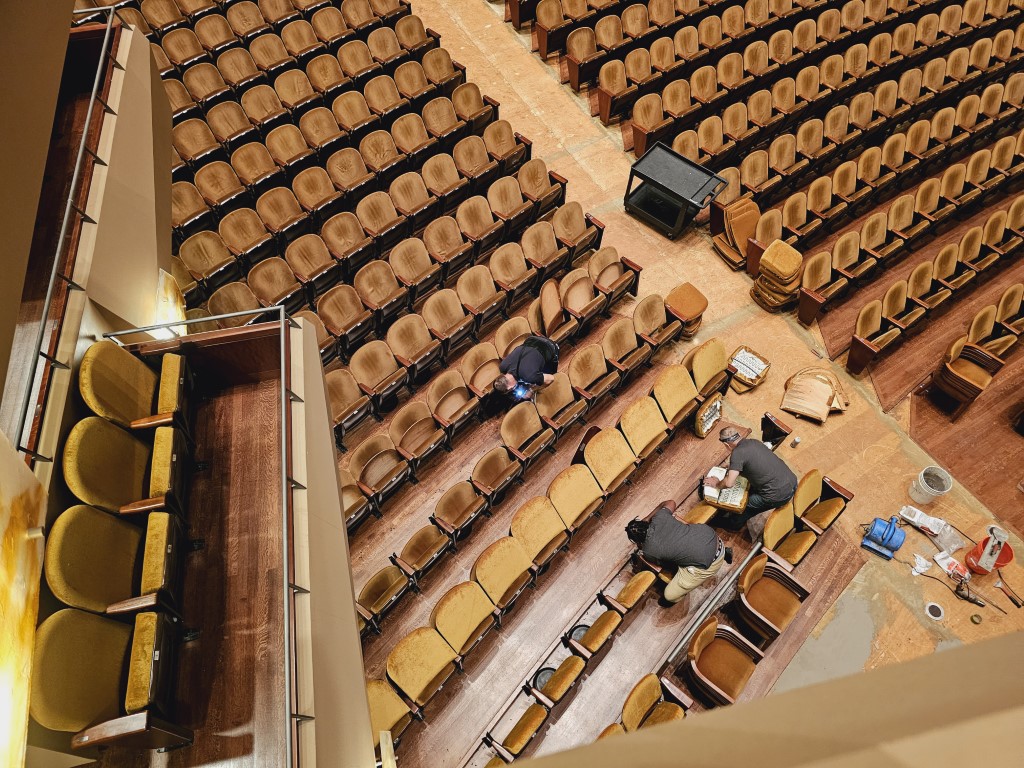 You always hear about the power of word of mouth advertising – some use it as a badge of honor, bragging that they don't have to spend a dime on getting their name out there. The prized referral is still truly the best chance to land a job in really any industry, but it will only take you so far if you don't do anything with it. Once received, you have a choice: follow up, or let it pass by. It's kinda like a train – you can jump on or jump off of it. If you jump on, it takes a little to get going, but once it’s gained momentum it’s rolling down the track at full steam. That's how we’ve felt about our business lately, especially on the commercial side of things.
You always hear about the power of word of mouth advertising – some use it as a badge of honor, bragging that they don't have to spend a dime on getting their name out there. The prized referral is still truly the best chance to land a job in really any industry, but it will only take you so far if you don't do anything with it. Once received, you have a choice: follow up, or let it pass by. It's kinda like a train – you can jump on or jump off of it. If you jump on, it takes a little to get going, but once it’s gained momentum it’s rolling down the track at full steam. That's how we’ve felt about our business lately, especially on the commercial side of things.
Earlier this summer, our business, Fabric Showcase, had an amazing opportunity to reupholster the fixed and loose seating at Benaroya Hall in Seattle, home of the Seattle Symphony. This year, the hall celebrates 25 years since its opening; it is a beautiful venue with a special focus on acoustical integrity.
Background
How exactly did a small upholstery shop in Cleveland get this 2,564 seat job in Seattle? That's a very good question, especially when most shops rarely get the opportunity to bid on projects of that size. To answer that question we have to go back to late 2018 when we were presented with a problem to solve. If any of you have made it to Mansfield, OH, you’ll know that it's known for Shawshank Prison, Snow Trails, and Mid-Ohio Race track – and not necessarily the arts.
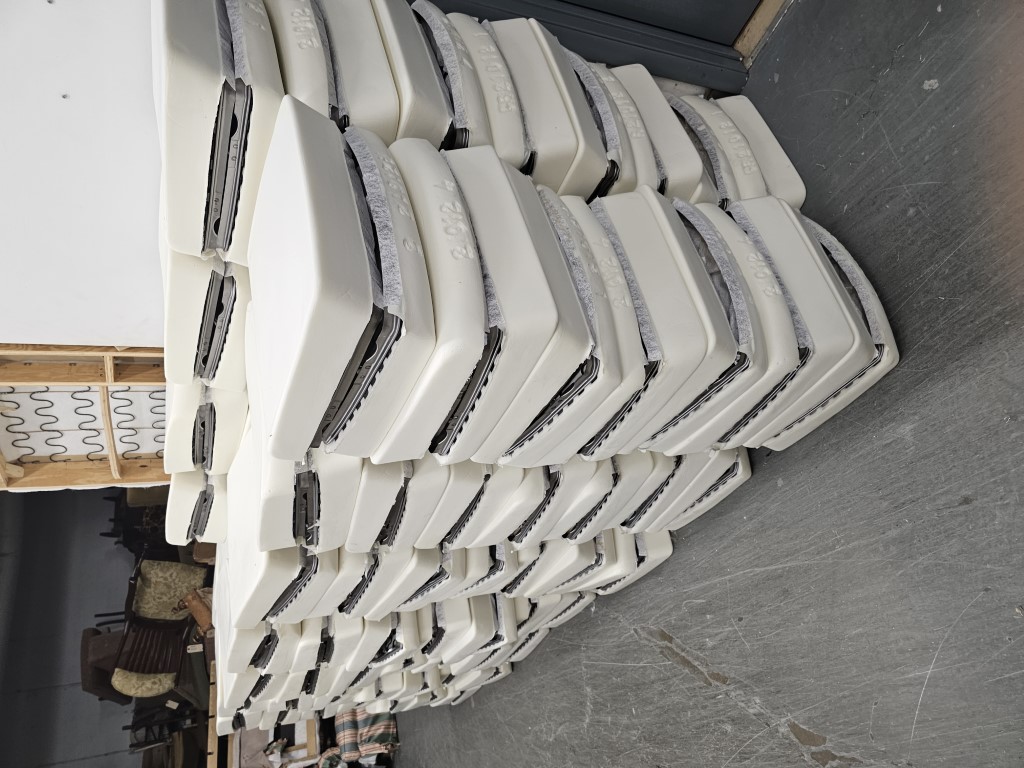
However, there is an absolutely beautiful theater in downtown Mansfield called the Renaissance Theatre, which opened in 1928. This theater approached us with a limited budget, requesting reupholstery of the worst 50 of their 1,400 seats. They wanted only the seats reupholstered, not the backs, which required matching the old maroon red velvet that was already faded and worn. We sourced a Kazmir velvet that was a perfect match. They approved, we completed the re-upholstery, and everyone was happy. Little did we know that the small Renaissance Theatre was a part of a larger organization, and when Benaroya Hall in Seattle was looking to renovate their seating, we were one of a few businesses that received a referral.
In late November 2019, about a year after the Renaissance project was complete, I was sitting in my office answering emails one morning when I saw an email with the subject line “Opportunity to Bid.” These usually come in my inbox once in a while for construction and non-upholstery type union jobs so they go straight to the spam folder. However, this email said “theater seats” at the end of the subject and it caught my eye. I opened the email and found about 40 pages of specs, including the 2,248 fixed seating project and 316 chair project for Benaroya Hall.
I called my dad and said “Hey Pops, check your email and tell me what ya think?” My dad is incredibly supportive and has always said “son, you dream it and I'll make it happen” so I pretty much knew what he was going to say. We accepted the notice, booked a flight and hotel, and scheduled a walkthrough.
Walkthrough and Bid
If you’ve ever done a walkthrough, it's a weird experience, because your competition is there at the same time, asking questions, talking about techniques and timelines. As a residential upholsterer that never happens, and if it does it's because the client accidentally double booked the both of you while attempting to get multiple quotes, making for a very awkward meeting. I was really excited to go on the road and was just happy for the opportunity to experience how the process works on the larger scale upholstery projects. But I definitely felt like a small fish in a very large pond.
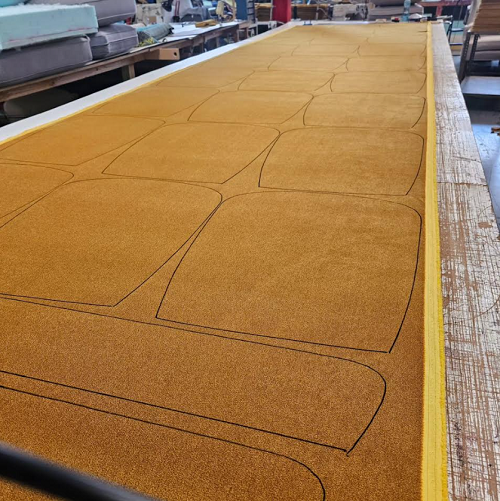
We approached it like the Renaissance project – we just moved the decimal
point over a few spots to the right. We estimated the time it would take to sew the bullnose seats, upholster the tight back panels, and procure all the supplies. We factored in Seattle living arrangements, car rental, and food for 7 weeks. What a job! We said a quick prayer, hit send, and just like that the bid was in; all the while not knowing that the world would soon come to a guillotine halt and the project of a lifetime we just bid on would be in jeopardy.
I won't bore you with the COVID details, but in short, we delayed 2 years, went through a few price increases, and in the end they stuck with us and we stuck with them. We made sure we had a good lawyer to go over all the legal jargon. Then, in January 2023 we amended the contract and secured a deadline of September (when the hall re-opened after the summer shut down) to have the
hall ready for its first show on September 15th. We broke up the project into 3 sections: Preparation, Production, and Installation.
Preparation
The most unique and vital part of this project was that the new chairs (seat and back) had to be within a certain measure of sound wave parameter to pass the acoustical test. The new chairs needed to absorb a specific amount of sound waves while in the upright position to ensure when the symphony plays that there is a pleasing amount of deflection and absorption. This was the most educational part of the whole project – learning how all the components affect the absorption of sound, including the covering fabric, fire barrier, foam, and adhesives – they all play a part on how sound waves are absorbed into the materials.
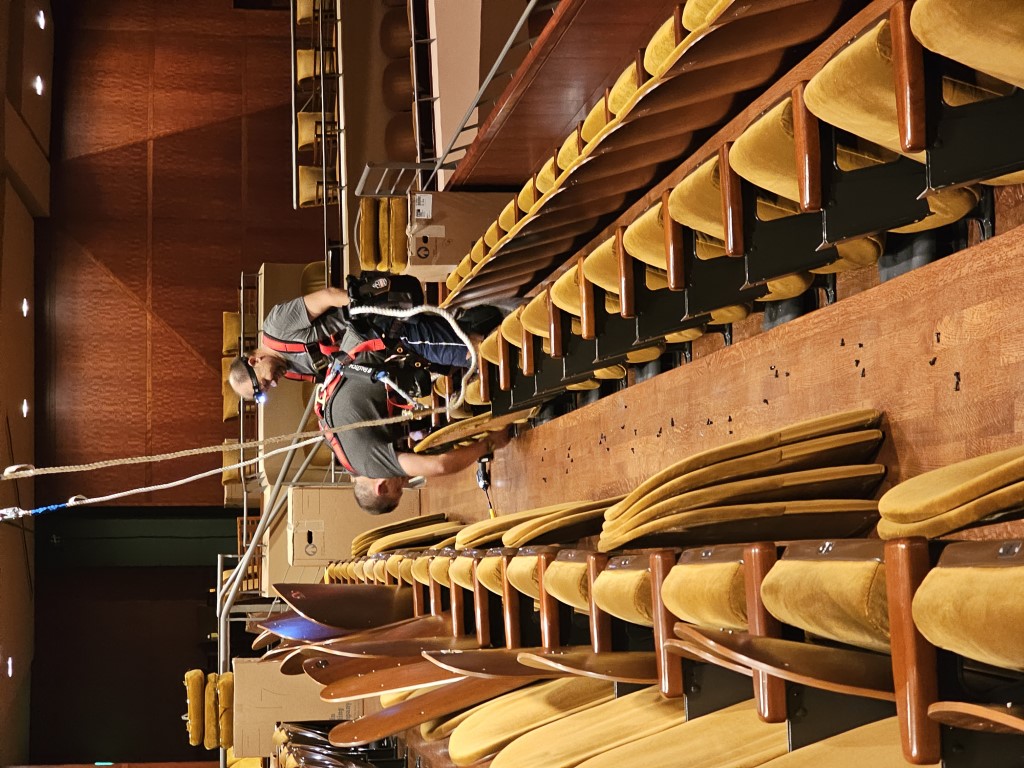
We had 8 chairs shipped to us, then mocked-up 2 rows just as they would sit in the hall redone in all new materials. Then off to Riverbank Acoustical Laboratories in Geneva, IL (outside Chicago) we went. The chairs were put in a sound chamber with two 18’’ thick walls for testing. The test took about an hour or so – we said another quick prayer – and we passed the test the first time! This was the biggest relief, because if the test seats fell out of range of sound absorption, we’d need to reselect fabric, possibly choose a different density of foam, and book at least one more trip to Chicago.
With the acoustical test behind us, we focused on getting all the materials in. The specs included every component to be shipped to us: the fabric arrived on six pallets, each with nine 30-50 yard rolls. The metal spring decks, seat foam, wooden curved backs, and back foam all arrived at our workroom in 2 semi truck loads to be unboxed, organized, assembled and upholstered.
Production
The day after Memorial Day 2023 was Production Day One. This was a challenge because we still had our own clients with projects in the schedule to complete. The key was to have a staff that was on board with the process, and everyone in the workroom was ready for one crazy summer. We assigned half of our staff to the Benaroya job and the others worked on our clients' projects. Each worker's skills were used to the max and we used the time as a teaching opportunity, getting out of our collective comfort zone.
One manager overseeing each of the two schedules ensured consistent quality and kept both production schedules flowing. We cut fabric for 3 weeks and kept our sewers and upholsterers busy all the way up to the day before the semi arrived. On July 29th, we loaded up the truck with the completed components. We said another prayer and then the truck was off, arriving in Seattle 5 days later.
Installation
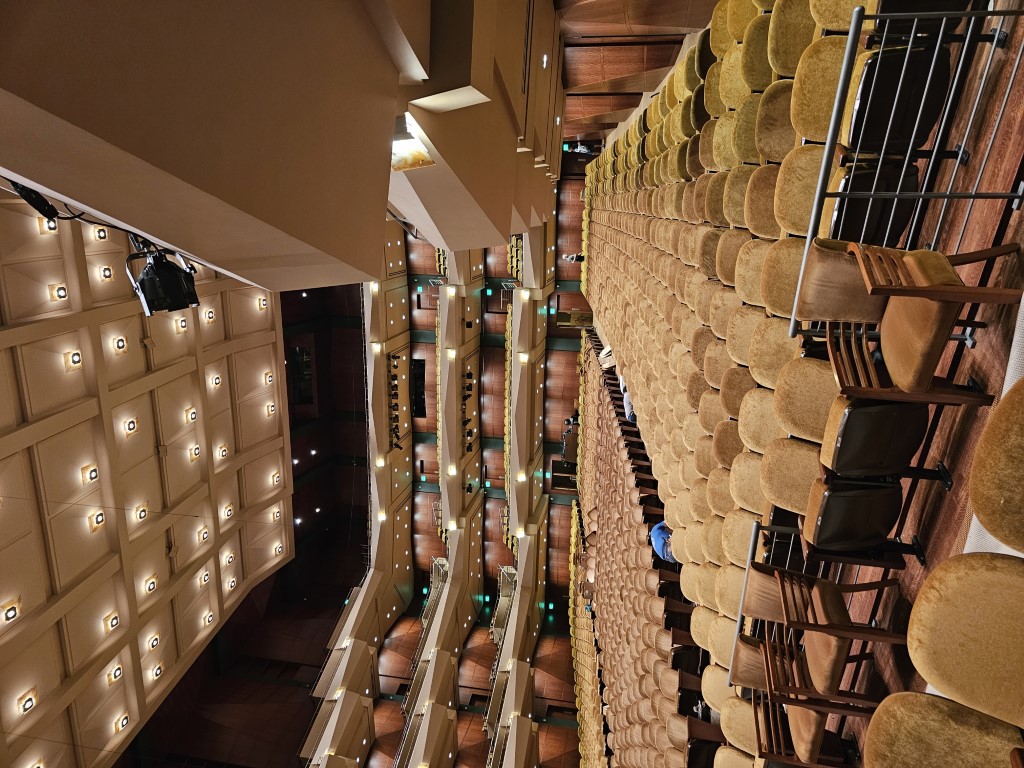
When our crew arrived in Seattle, ahead of the truck, we were presented with a unique situation – we had to be tied off due to the low railing on the balconies. Because we were performing work so close to the low railing, the city required us to go through a training program. (Apparently, a guest in high heels can sit and walk in the front row of the 3rd tier balcony with a glass of wine, but we couldn't peek over the same railing without a full harness.) So off to 2 days of fall protection training we went. Our semi arrived on time and we began the process of removing the old seats and backs, replacing them with the freshly upholstered components from our Cleveland, OH workroom. The harnesses were annoying but the goal was to keep everyone safe, so we pushed through.
These were long days and nights as we unpacked 400+ large boxes, making sure all the sizes and components went exactly where they were supposed to. We disassembled all the old seats and backs, discarded them into countless trips to the dumpster, and then installed the new seats and backs. We finished the 2,248 fixed seats and started the second phase: the 316 loose chairs that were scattered throughout the building. We had laborers tearing off the old materials from the chairs while the upholsterers applied the cut foam and fabric we prepared back home ahead of time. All said, we spent 7 weeks in Seattle and overall it's a beautiful place. Mt. Rainier greeted us each day with a mirage-like picture that looked almost fake as we traveled down Interstate 5 south to our condo.
Conclusion
These were some of the highlights of our project with still many details left out that time couldn't allow. I can't say enough about the staff there at Benaroya Hall, LMN Design, and Andrew Clapham and Associates; we were very blessed to work with their clear vision, ability to accommodate, and laughs during our stay. In total, we spent 7 weeks on-site and each sacrificed a lot to make it happen. But in the end, this is a story about how a small upholstery shop in Cleveland used a referral from Mansfield to upholster 2,500+ seats in Seattle.
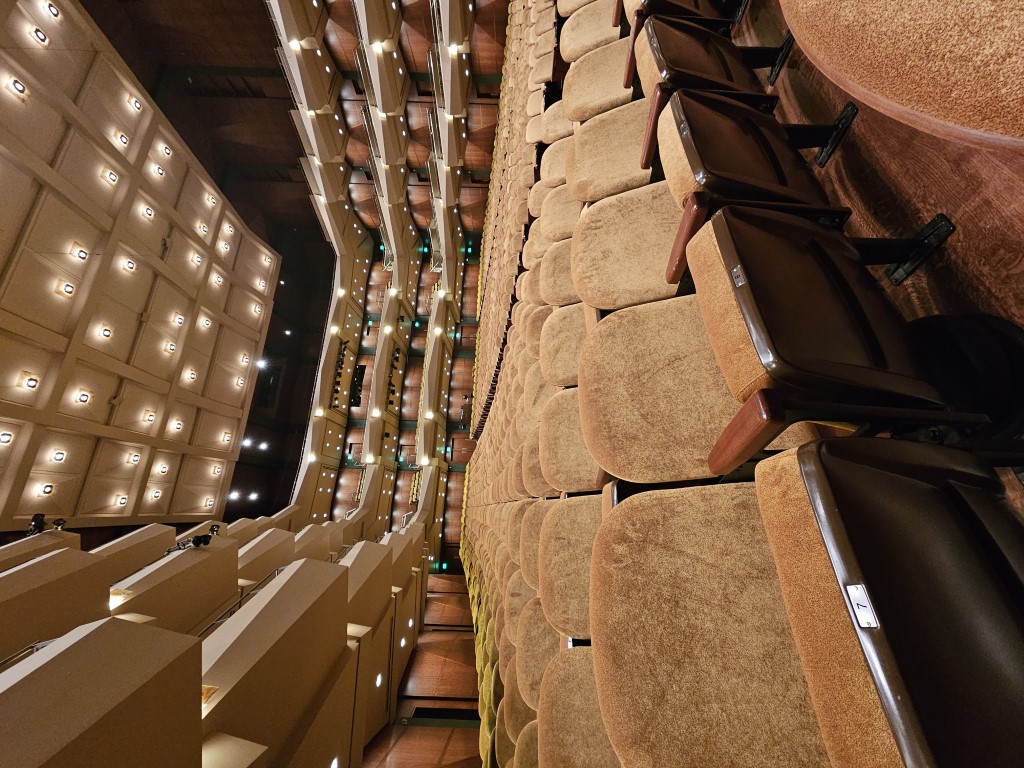
Word of mouth is still undefeated.